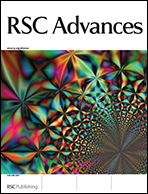Surface zwitterionically functionalized PVA-co-PE nanofiber materials by click chemistry
Abstract
Antifouling nanofibers with zwitterionic materials on surfaces that can prevent the nonspecific adhesion of biomolecules and microorganism are in demand for high efficiency biosensors and affinity membranes. The functionalization of zwitterionic sulfobetaine on surfaces of PVA-co-PE nanofiber membrane via click chemistry is performed employing two synthesis routes and reported in this paper. PVA-co-PE nanofiber membranes were activated with cyanuric chloride, and then surface functionalized with sodium azide or 2-propynylamine to prepare “clickable” nanofibers with azide or alkynyl groups, respectively. The zwitterionic sulfobetaine was finally “clicked” onto PVA-co-PE nanofiber membranes. The successful surface functionalizations of PVA-co-PE nanofiber membrane were confirmed with FTIR-ATR, Raman spectroscopy, XPS and EDS. The analysis of element composition using XPS indicated that alkynylation of activated PVA-co-PE nanofiber membranes can “click” more sulfobetaines on nanofiber surfaces than surface azidation. SEM results showed that functionalized PVA-co-PE nanofiber membranes maintained well-defined nanofibrous morphology. PVA-co-PE nanofiber membranes with zwitterionic sulfobetaine demonstrated excellent antifouling performance by effectively resisting bovine serum albumin (BSA) protein adsorption.


 Please wait while we load your content...
Please wait while we load your content...